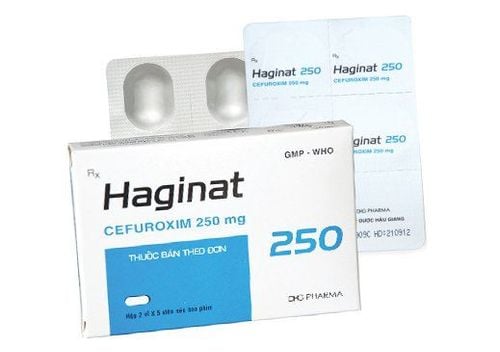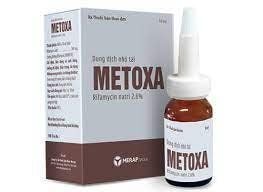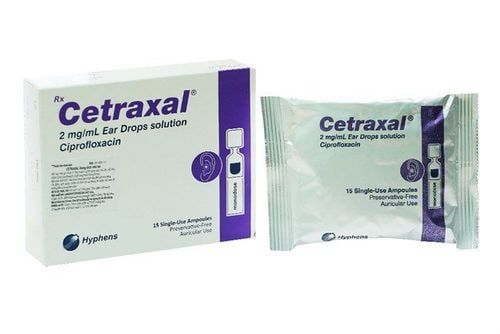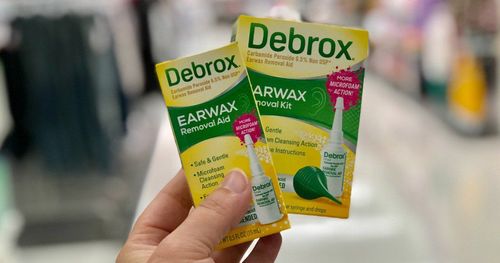This is an automatically translated article.
Illixime is prescribed by doctors to treat ear infections caused by bacteria, such as otitis externa, chronic purulent otitis media or acute otitis media. During the use of Illixime, patients should strictly follow the doctor's treatment plan to recover soon.
1. What is Illixime?
What is Illixime? Illixime drug belongs to the group of drugs for the treatment of eyes, ears, nose and throat; manufactured by Hanlim Pharm Co., Ltd – Korea. Illixime is often used by doctors for ear infections caused by bacteria and to prevent the risk of infection or infection after surgery.
Currently, Illixime is prepared in the form of a light yellow or lemon yellow ear drop solution and packaged in a box of 1 bottle of 5ml. In each vial of Illixime ear drops, the main ingredient is Ofloxacin with a concentration of 15mg and other excipients just enough.
2. What is the effect of Illixime?
2.1 Uses of Illixime The ofloxacin active ingredient in Illixime ear drops is known for its broad-spectrum antibacterial activity, which can be used against both Gram-positive and Gram-negative bacteria. The main antibacterial mechanism of this active substance is inhibition of DNA gyrase - an enzyme that is essential for the replication, transcription, repair and recombination of bacterial DNA. When this enzyme is inhibited, the bacterial DNA becomes unstable and leads to cell death.
Currently, a number of studies have reported the occurrence of cross-resistance between the active ingredient Ofloxacin and other fluoroquinolones. However, Ofloxacin is not cross-resistant with beta-lactam antibiotics or aminoglycosides.
According to experts, the active ingredient Ofloxacin in Illixime ear drops has antibiotic activity against the following species of bacteria:
Aerobic Gram-positive bacteria such as Streptococcus pneumoniae or Staphylococcus aureus. Aerobic Gram-negative bacteria such as Haemophilus influenzae, Escherichia coli, Moraxella catarrhalis, Pseudomonas aeruginosa and Proteus mirabilis. 2.2 Indications to use Illixime Currently, Illixime is often prescribed by doctors to treat the following conditions:
Treatment of otitis externa for children > 6 months old and infected adults Pseudomonas aeruginosa, Escherichia coli and Staphylococcus aureus. Treatment of chronic otitis media with pus caused by Staphylococcus aureus, Pseudomonas aeruginosa and Proteus mirabilis bacteria strains for children > 12 years old with perforated tympanic membrane. Treatment of acute otitis media caused by strains of Moraxella catarrhalis, Pseudomonas aeruginosa, Haemophilus influenzae, Streptococcus pneumoniae and Staphylococcus aureus in patients > 1 year of age who are undergoing ear catheterization. 2.3 Contraindications to the use of Illixime Do not use Illixime in the following cases without being prescribed by a specialist:
Patients with a history of hypersensitivity or allergy to Ofloxacin or any of the active ingredients other in the drug. Patients with perforated eardrums, severe ear trauma, or ear burning are not caused by bacteria. Illixime ear drops are contraindicated in children under 1 year of age.
3. Dosage and usage of Illixime
3.1 Dosage of Illixime The following is the dose of Illixime ear drops recommended by the doctor:
Treatment of otitis externa:
Dose for children from 6 months to 13 years old: 5 drops a day (equivalent to 5 drops per day) equivalent to 0.75mg Ofloxacin) into the infected ear and use the drug within 1 week. Dose for children > 13 years old: 10 drops (equivalent to 1.5mg Ofloxacin) daily in the infected ear and use the drug within 1 week. Treatment of chronic otitis media with pus: Dose for patients over 12 years old: 10 drops / time x 2 times / day and use the drug within 2 weeks.
Treatment of acute otitis media: Dose for pediatric patients from 1 to 12 years old: Instill 5 drops / time x 2 times / day into the infected ear and use the drug within 10 days.
3.2 Instructions for effective and correct use of Illixime Before using Illixime, patients should carefully read the instructions for use and follow the instructions of the doctor. Here are the steps to help you apply Illixime correctly and effectively:
The patient lies on the bed with the head tilted to one side. Gently pull the earlobe, then put the tip of the Illixime vial into the inside, gently squeeze to drop the medicine drop by drop according to the prescribed dose. The patient should lie still for 2-3 minutes so that the solution is absorbed evenly and does not leak out. Patients should warm the vial of Illixime by hand, avoiding very cold drops in the ear, as this may cause irritation. In case of feeling tinnitus after instilling Illixime solution, the patient can use a cotton swab to absorb the amount of medicine. Absolutely do not use Illixime for eye drops. 3.3 How to handle missed dose or overdose of Illixime In case of missed dose of Illixime ear drops, the patient should immediately take the replacement dose at the earliest time. However, too much should be avoided, because it is easy to cause an overdose.
If you notice reactions such as rash or itchy ears after using an overdose of Illixime, the patient should promptly notify the doctor for treatment.
4. Possible side effects when using Illixime
During the treatment of ear infections with Illixime, patients may experience the following side effects:
Common: Hypersensitivity, skin rash, mild dizziness, stinging and itchy ears . Uncommon: Drug resistance, fungal infection, insomnia, sleep disturbance, agitation, dizziness, fatigue, headache, nasopharyngitis, cough, eye irritation, nausea, vomiting, diarrhea, pain abdomen, rash and itching. Rare: Angioedema, anaphylaxis, anorexia, anxiety, psychosis, depression, nightmares, taste disturbances, paresthesias, somnolence, vision disturbances, hypertension, rhythm tachycardia, bronchospasm, dyspnea, gastrointestinal bleeding, enteritis, urticaria, hyperbilirubinemia, increased liver enzymes, tendinitis or increased serum creatinine. Very rare: Anemia, leukopenia, hemolytic anemia, thrombocytopenia, motor neuron disorder, peripheral neuropathy, convulsions, hearing loss, tinnitus, jaundice, colitis pseudomembranous, toxic epidermal necrolysis, erythema multiforme, erythema chromatin, photosensitivity, vasculitis, purpura, arthralgia, myalgia, tendon rupture (occurs within 48 hours of from the start of instillation) or acute renal failure. Frequency unknown: Ventricular arrhythmia, hearing loss, loss of taste, movement disorder, bone marrow failure, hypoglycemia, flatulence, constipation, acute interstitial nephritis, liver damage,... When any side effects appear during the use of Illixime, the patient should notify the doctor as soon as possible for treatment. Some adverse effects may disappear or become serious when not corrected early.
5. Things to keep in mind when using Illixime ear drops
5.1 What precautions should be taken while using Illixime? Patients should note some of the following things in the process of using Illixime ear drops:
Use only Illixime for local treatment in the ear, not for injection or eye drops. There is a risk of serious hypersensitivity reactions, even death, from intravenous anaphylaxis shortly after the first dose in patients receiving systemic quinolones. When conditions such as allergic reactions with loss of consciousness, shock, angioedema, urticaria, itching, difficulty breathing or airway obstruction occur, patients should immediately discontinue use of Illixime and notify their physician for treatment. . Severe anaphylactic reactions can be managed by airway management, oxygen delivery, and intubation. Similar to antibacterial drugs, long-term use of Illixime ear drops can lead to the growth of non-susceptible strains of bacteria, including fungi. If superinfection occurs, the patient should stop taking the drug and take an alternative medicine as prescribed by the doctor. In case the ear infection does not improve after 1 week of treatment, the patient should consult the doctor for further treatment instructions. After completing the course of treatment, if there is still pus in the ear or 2 or more times of pus appear in the ear within 6 months, the patient should report to the doctor for further evaluation of the disease. Thereby eliminating the risk of having a foreign body or tumor located in the ear. Use caution when administering Illixime nasal drops to patients with signs of sensitivity to other quinolone antibiotics. The drug has the risk of causing adverse symptoms such as headache, dizziness, reduced vision, ... so caution should be exercised when using Illixime for patients who have a job to drive or operate machinery. Taking high doses of Illixime can cause birth defects, so women who plan to become pregnant or are pregnant need to be careful when using it. It is not known whether ofloxacin is excreted in human milk, however there is a risk of dangerous side effects in a nursing infant. Therefore, women who are breastfeeding need to be cautious when using Illixime, it is best to take it only if prescribed by a doctor and the benefits far outweigh the risks. 5.2 Interactions of Illixime with other drugs Some other drugs may interact with Illixime, including:
Systemic quinolones that inhibit the metabolic clearance of Theophylline and Caffeine. Increased incidence of CNS toxicity when systemic fluoquinolones are administered concurrently with nonsteroidal anti-inflammatory drugs. Possible prolongation of the QT interval when Illixime is co-administered with class IA antiarrhythmics, macrolides, tricyclic antidepressants and antipsychotics. Illixime is prescribed by doctors to treat ear infections caused by bacteria, such as otitis externa, chronic otitis media with pus, or acute otitis media. During the use of Illixime, patients should strictly follow the doctor's treatment plan to recover soon.
Please dial HOTLINE for more information or register for an appointment HERE. Download MyVinmec app to make appointments faster and to manage your bookings easily.













